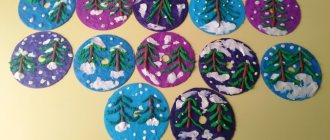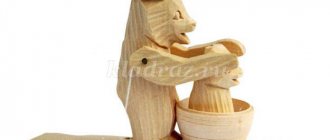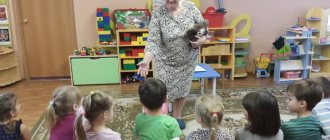Lesson on getting acquainted with fiction in the senior group
Senior group
Topic: “Visiting the writer S. Ya. Marshak.”
Goals and objectives: To summarize children’s knowledge about the writer and his works. Continue to teach children to memorize poems. To develop intonation expressiveness of speech and artistic abilities of preschoolers.
Cultivate an interest in literature, a desire to get acquainted with the work of Marshak.
Equipment: books by S. Ya. Marshak, illustrations for his works, a portrait of the writer, costume attributes for reading and dramatizing poetry, schematic drawings for memorizing, origami crafts, colored pencils.
Reading to children and listening to audio recordings of works by S.Ya. Marshak. Verbal games and exercises to develop tempo, timbre, melody of speech and logical stress. Learning by heart excerpts from the poems “Mustache - Striped”, “He’s so absent-minded”, “Luggage”, “A Lesson of Politeness” and dramatizing them. Making origami “cat” crafts with children
Summary of an open lesson on familiarization with fiction in the senior group.
Summary of direct educational activities in the senior group (age 5-6 years) on the topic: “A magical journey into a winter fairy tale.”
Author: Alvarian Asmik Khachikovna, GBOU school No. 1566 (preschool department No. 2313), Moscow Description of work: I offer you a summary of direct educational activities for children of the older group (5-6 years old) on the topic “A magical journey into a winter fairy tale” This material will be useful for a teacher of a senior group.
This summary is of an educational nature, aimed at expanding and understanding one’s emotional state through the literary work of the Russian folk tale “The Snow Maiden”. Integration of educational areas:
Cognitive, speech, artistic and aesthetic development
Goal: Awareness of one’s emotional state through the literary work of the Russian folk tale “The Snow Maiden”.
Objectives:
Developmental
• continue to develop a poetic ear: the ability to hear and highlight expressive means in the text;
• develop in children the ability to holistically perceive a fairy tale in the unity of its content and artistic form; • develop aesthetic perception of pictures of nature, artistic text; • development of auditory and visual perception, attention, memory and logical thinking; • develop creative imagination, the ability to see and notice the expression of a person’s emotional state in illustrations depicting people; • develop fine motor skills of the hands. Educational
• teach to analyze feelings using artistic and visual means;
• teach children to emotionally perceive the figurative content of a fairy tale; • continue to introduce children to emotions; • strengthening the ability to form a relative adjective; • consolidate the skill of word formation and inflection; • activation of the dictionary of signs on the topic “Winter”; expand the vocabulary on the lexical topic “Winter”; • continue to teach children the cause-and-effect relationship (guess riddles); • consolidate the ability to compose a detailed sentence. Educating
• cultivate a love of nature;
• cultivate children's persistent cognitive interest in expressing their emotional state; • create a relaxed atmosphere; positive emotional background; encourage children to perceive each other positively; • evoke in children feelings of admiration and admiration for the beauty of the winter landscape; • cultivate accuracy when working with glue and paper. Developmental environment: Illustrations on the theme “Winter”, and winter fun;
music for the lesson; pillows for each child; fairy tale "Snow Maiden"; artificial snowballs for playing; Snow Maiden doll; material for artistic creativity (corrugated paper, PVA glue, straw) for each child; various illustrations depicting the Snow Maiden. Progress of the lesson:
Educator: Hello, dear guests! Children's answer: (children say hello) Educator: Guys, look how many guests we have today. They came to us to see how smart, responsive, friendly you are, how smart you are, how much you already know and can do. Educator: Children, look how beautiful it is outside the window. What time of year is it now? The teacher and the children come to the window where there is an easel with illustrations. The teacher shows illustrations of winter landscapes. Children's answer: Winter! Educator: Yes, now winter is in charge of nature. What signs of winter do you know? Children's answer: Lots of snow, cold, frosty, etc. Educator: Correct. Snowy frosty days have arrived, a lot of snow has fallen, it has enveloped fields, forests, houses in a white fluffy blanket - it has become light, elegant, fabulously beautiful! Educator: Tell us what winter fun children have, what do you like to play in winter? Children's answer: Snowballs, sleds, skis, make snowmen. Educator: Guys! And I know a very interesting winter, Russian-folk tale about a snow girl. Do you want to know this fairy tale? Children's answer: we want! Entering the fairy tale Educator: But from the beginning we need to get into it. To do this we need to stand in a circle. The children, together with the teacher, go to the carpet and stand in a circle. Educator: “Our... heart will help us on our journey. The heart has incredible power if it is kind, loving, trusting and joyful. I think each of you has such a heart. Now place your right palm on your chest, close your eyes and quietly listen to how your warm, kind heart beats... Mentally ask your heart to give you the strength to travel through a fairy tale.” Reading the Russian folk tale "The Snow Maiden" Educator: Guys, let's quietly, so as not to frighten off the fairy tale, take each of your own pillows and sit down on the carpet, wherever it is convenient for you, take a comfortable position. (Children sit on the carpet on their own pads, in a comfortable position.) Educator reads a fairy tale
.
Educator: Yes, guys, at the end of this fairy tale we all experience feelings of light sadness. We are sorry that the Snow Maiden melted, but you and I know that every winter the Snow Maiden is reborn again, because we sculpt her from snow. What else can you make from snow? Educator: Guess my riddle: There is only one fun in winter. Everyone needs accuracy and dexterity in it. What do you call “shells”, what do you sculpt and throw at your friends? Children's answer: Snowballs! Educator: Do you want to play in the snow? Children's answer: Yes! Educator: Get up, remove the pads. Children split into 2 teams and throw snowballs into baskets
.
During the game, the teacher reads a poem Educator : Love in winter A fun snow fight! Taking aim carefully, hit the enemy. Swing your arm - throw! A snowball is flying straight to the target! Educator: That's what a snowdrift we got!!! Let's try to make a Snow Maiden out of it: The teacher approaches the basket with “snowballs” and reads a magic spell (the children stand nearby).
She is dressed in silver with pearls.
The magical granddaughter of a magical grandfather! Show up! The Snow Maiden doll appears.
The teacher reads the poem and puts the Snow Maiden on the table .
Educator: I am the granddaughter of Frost and Blizzard, I come here every year! The snowflakes and my friends are dancing with me in a round dance! Q: Children, let's remember how the Snow Maiden appeared in a fairy tale with his grandfather and woman? Children's answer: ... Educator: How much snow fell, what did the houses and everything around look like when the grandfather and woman went to sculpt their daughter? Let's remember how this is said in the text. Children's answer: ... Educator: What was the Snow Maiden's mood in winter? What was she like? Children's response: Joyful, friendly, cheerful, happy, affectionate, etc. The teacher examines book illustrations with the children. Educator: Look at how different Snow Maidens are. How did you understand that in this illustration the Snow Maiden is in a cheerful mood? Children's answer: There is a smile on her face, her eyes are shining... Educator: The beautiful girl is sad: She doesn’t like spring, She feels hard in the sun! The poor thing is shedding tears. The teacher reads a poem and shows illustrations of the Snow Maiden in the spring.
What kind of Snow Maiden did she become in the spring?
Children's answer: Sad, sad. Educator: Look how the artists convey the sadness of the snow girl? Children's answer: Bowed head, sad face, sitting, bending over. Educator: Guys, so that the Snow Maiden doesn’t feel sad, let’s give her gifts. Take your seats. Children sit in their places with the prepared material. Educator: When the Snow Maiden cries, thawed patches appear, and on thawed patches they grow... I was the first to get out of Zemlitse On the thawed patch. He's not afraid of frost, even though he's small? What is this? Children's answer: Snowdrop! Educator: Correct! You and I will make snowdrops for our Snow Maiden. Educator: Near the snow-covered hummocks, Under the white snow cap, We found a small flower, Translucent, almost alive. Children, together with the teacher, make snowdrops from corrugated paper as shown by the teacher. Educator: What wonderful snowdrops we got! Carry them in the basket. Educator: Now our guest has become completely cheerful! Children bring their fakes to the teacher. The teacher puts them in a basket next to the Snow Maiden. Educator: Guys, let's remember what emotions the Snow Maiden experienced in Winter? Children's answer: Joy, admiration, happiness, delight, pleasure. Educator: And in the spring, what emotions did the Snow Maiden experience? Children's answer: Sadness, sadness, despondency... Educator: Well, guys, it's time for us to return back to kindergarten from our trip. Close your eyes, place your right palm on your chest, listen to your heart beat... Thank him for the magical journey. The teacher sums up the lesson while sitting on the carpet with the children. Educator: Today you proved that you have a kind, loving heart. Where did we travel today? Children's answer: To a fairy tale! Educator: What did you like most about our trip? Children's answer: ..... Educator: How did you feel when you made a gift for the Snow Maiden with your own hands? Children's answer: .... Educator: Thank you very much!
We recommend watching:
GCD for the older group. My city Abstract of OOD in the senior drawing group. Leaves of trees Open integrated lesson in the senior group. Works by Marshak Abstract of an integrated educational activity on cognitive development in a group of senior preschool age on t
Similar articles:
Thematic lesson in the senior group. Slavic mythology
Lesson on socio-communicative development and social education in the senior group
Lesson on etiquette and politeness in the senior group
Lesson notes for the senior group. Adult labor
Summary of a lesson in the senior group on the topic: “Pedigree”



